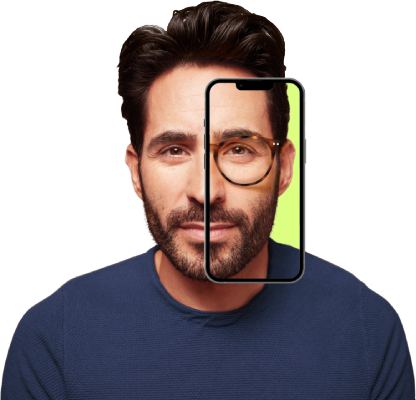
With our virtual try-on tool, finding your perfect pair is as easy as looking into your camera.
Everything you need to know to take care of your eyes — for life.
Oval, round, square, heart, diamond, triangle — knowing your face shape can help you choose eyeglass frames that flatter your features.

Shopping for new eyeglasses or prescription sunglasses? There are a host of factors that go into finding glasses that you’ll love and want to wear day after day. One of those factors is your face shape.
“We’re all different shapes and sizes,” says Natalie Martin, a Tampa, Florida–based optician and regional learning specialist for National Vision. “Those different shapes and sizes play a role in the way glasses look on you.”
But the first step is to figure out what your face shape is. That’s where this four-step guide comes in. Who knows, you could just find your perfect pair by the time you’re done!
No one has a face that’s perfectly round or square, of course. But we all have a predominant shape that matches one of these six main shapes.
Looking for a stylish bargain? See how much you can save when you buy two pairs of glasses. Browse our new collections here.
Find a mirror and note these four features:
As a general rule of thumb, “the widest part of your face determines your dominant face shape,” says Martin.
Do you have a couple of areas that could be considered the widest part? That’s common, she adds. “There are many face shapes where two parts of your face are the same width.”
That’s where it helps to take note of the lines and angles of your face. When you look at your forehead, cheekbones, jawline, and chin, is everything softer and rounded or is it more angular? Oval, round, and heart face shapes lean more toward curves, while the other three are more linear.

With our virtual try-on tool, finding your perfect pair is as easy as looking into your camera.
By now, you probably have a pretty good idea of your dominant face shape. Technology can help confirm your decision.
There are two tools that can help:
Let’s say you’ve ruled out five of the shapes and determined you’re a diamond. What’s next? After all, frames aren’t organized by face shape.
Now’s a good time to brush up on the frame shapes that complement your face shape. Our frame guides can help:
“When shopping for glasses, you don’t need to come into the store armed with every bit of knowledge,” says Martin. “It’s okay to know that face shape might factor into finding flattering frames, but not know what face shape you have.
“Your optician will ask you questions about your eyewear preferences, look at your prescription, and also check out your face shape.”
In addition, there are other details, which are difficult to determine on your own, that make a difference in the frame style and shape that’s suited to you.
Pupillary distance is one such factor. This is the distance between the pupils of your eyes. Whether your eyes are set narrow or wide makes a difference in the frame size that’s best for you and your visual clarity, says Martin.
Shopping online? Take advantage of our Virtual Try-On Tool. When you see a style you like, click the “create a virtual try on” button to see how the frames look on you. It’s a great way to experiment with different styles of frames to see what fits your face the best — even those you’re curious but unsure about.
“Frames come in multiple sizes, and we can identify the frame you like and get it in the best size for you,” she says. Your optician can then help you choose a selection of frames to try on.
“A lot of this process is done by having a conversation about what you liked and didn’t like in the past about your glasses and what you’re looking for now,” Martin says. “We aim to learn as much about your tastes and lifestyle as possible to get the right frame, so you walk out of here happy.
Face shape can be a good guide — but it’s not the only thing to consider.
Recommended reading: 5 Tips to Find the Best Glasses for Your Face Shape
Recommended video: How to Find the Best Glasses for Your Face